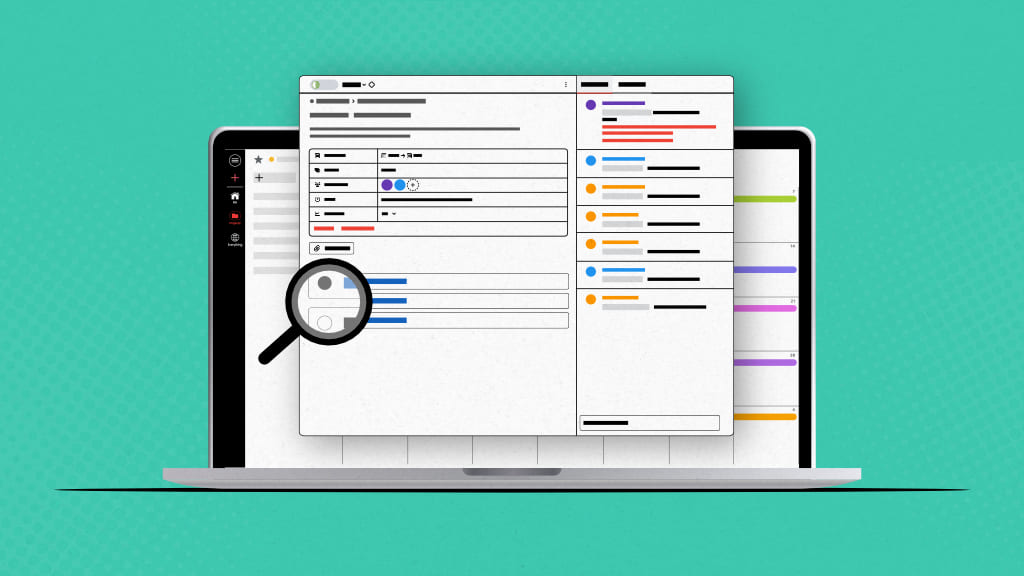“Big things are built one step at a time.”
This statement has been a guiding principle in my project management journey. Over the years, I have learned that the difference between a successful project and one that faces difficulties often lies in the ability to break it into manageable parts – project subtasks.
Like many first-timers, I still remember an episode where I had to manage a project that felt like a tangled mess of deadlines, unclear expectations, and moving pieces.
Every morning, I’d open my project list and feel overwhelmed. What needed attention? What had fallen through the cracks? It was chaos. Then, a mentor taught me a simple yet powerful technique: break down big, ambiguous tasks into clear and actionable subtasks. And since then everything has changed for the good!
Now, I no longer see work as an intimidating mountain, instead, I see a series of stepping stones to the finish line. Project subtasks have brought in a lot of clarity, focus, and direction – a way to connect small, actionable steps to larger ambitious goals.
But let’s be honest: breaking a large project into smaller, actionable pieces isn’t always as straightforward as it sounds. Sometimes, you find yourself bogged down by unclear priorities, missed deadlines, or a creeping sense of chaos.
Trust me, I get it – I have been there too. The good news is that with the right approach, subtasks can elevate your project management from “barely holding it together” to “effortlessly in control.”
In this article, I’ll guide you through what project subtasks are, their benefits, and, most importantly, how to manage them effectively. Whether you’re leading a small team or managing a cross-functional one, you’ll learn some best practices to manage subtasks effectively.
A Free guide to help you with proven ways to lead a project from start to finish, without confusion or jargon.

Before we begin, let’s discuss what a project subtask is.
What are project subtasks?
Project subtasks are smaller, more specific components of a larger task. By breaking down your project into subtasks, you can create manageable and structured steps that make the overall process more organized and achievable. Subtasks make sure that there is clarity, focus, and a systematic approach to project completion.
Let’s understand with an example – suppose you are working on the launch of a new website marketing campaign for your company. That’s your project!
You can divide it into primary tasks such as “Planning,” “Content creation,” and “Execution.” Then, you can further break down each of these tasks into subtasks. For example:
Planning
- Conduct market research and collect data
- Define your target audience, including their needs and behavior
- Set campaign goals
Content creation
- Design promotional graphics
- Write ad copy
- Produce video content
Execution
- Schedule social media posts
- Launch email campaign
- Monitor performance metrics and statistics
Each subtask has its deadline, responsible team members, and specific deliverables. This detailed structure allows you to allocate resources more effectively, monitor progress, and identify potential challenges before they become significant issues.
Breaking tasks into subtasks also makes it easier to track progress more straightforwardly. Completing a defined subtask like “Conduct market research” or “Produce video content” provides a sense of accomplishment to your team members and ensures that the project advances step by step. By structuring your project into clearly defined subtasks, you create a framework for effective task management and successful project completion.
What are the key benefits of using subtasks in project management?
Breaking tasks into subtasks does much more than keep you organized; it provides a framework for tackling challenges, staying productive, and avoiding pitfalls.
Using subtasks in project management can benefit you in several ways and here are a few of them:
- Enhanced cost and time forecasting: Subtasks allow you to make a more accurate estimation of time and resources, thereby reducing the likelihood of projects exceeding budgets or deadlines.
- Identification and resolution of bottlenecks: Breaking down tasks into subtasks helps you identify potential bottlenecks or inefficiencies early so that you can take prompt corrective actions.
- Improved adaptability: Subtasks provide you the flexibility to adjust plans as projects evolve, ensuring alignment with overall goals.
Also read: Project management plan – everything you need to know about
- Clear checkpoints and milestones: Project management subtasks make it easy to set and monitor checkpoints, allowing teams to stay on schedule and achieve milestones.
- Increased productivity and efficiency: Dividing tasks into subtasks allows your team members to focus on specific, manageable components, and ultimately get more done in less time.
- Improved communication and transparency: Clearly defined subtasks clarify who is responsible for what, improving team communication and collaboration.
How to create effective project subtasks and manage them in ProofHub
ProofHub is an all-in-one project management and team collaboration tool that is trusted by teams across the globe to plan and execute projects efficiently.
It has a robust task management system with a plethora of robust features making everyday work a cakewalk.Creating project tasks and subtasks in ProofHub is super easy, and we shall discuss how you can create subtasks in a project easily with ProofHub.
1. Open the task detail window: Navigate to the task where you want to add subtasks.
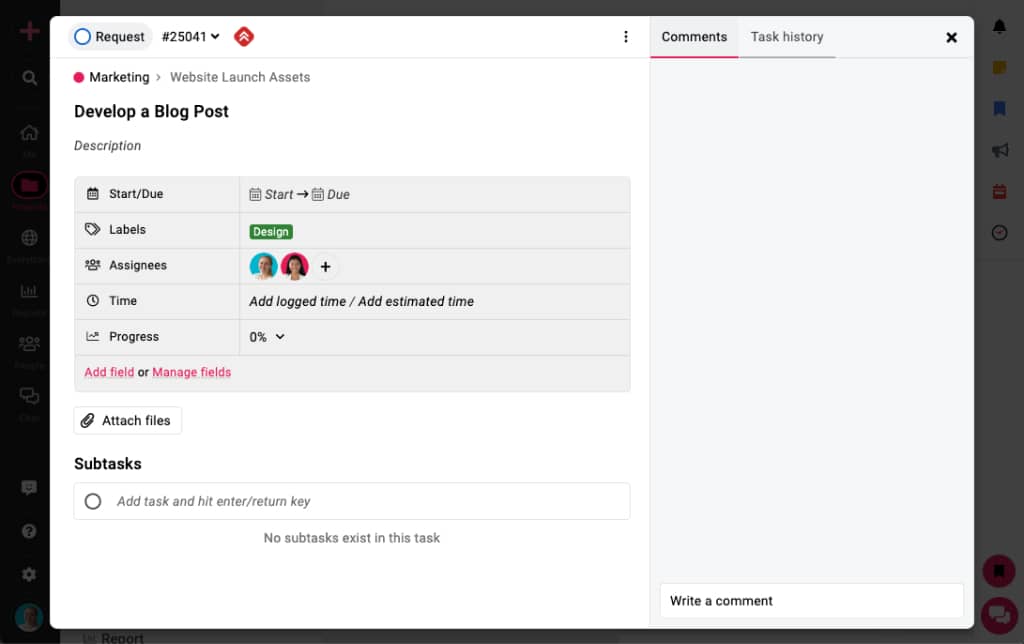
2. Add a subtask: Click on the “Add task” option under “Subtask” menu within the task detail window. Type the title of the subtask and provide its clear description.
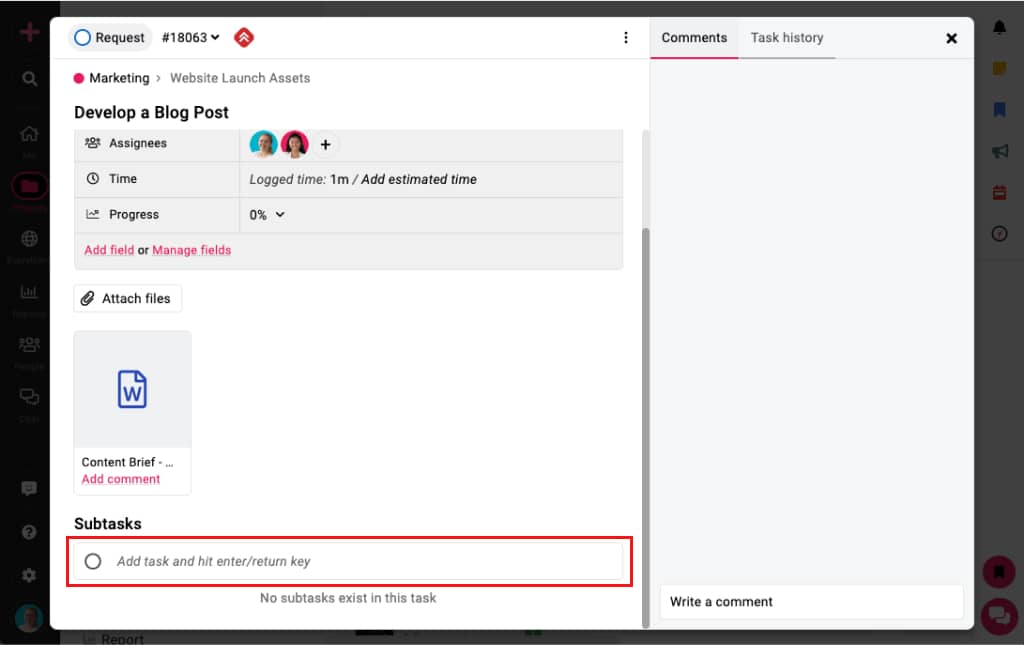
3. Assign responsibilities: Assign the subtask to a specific team member or multiple team members at once.
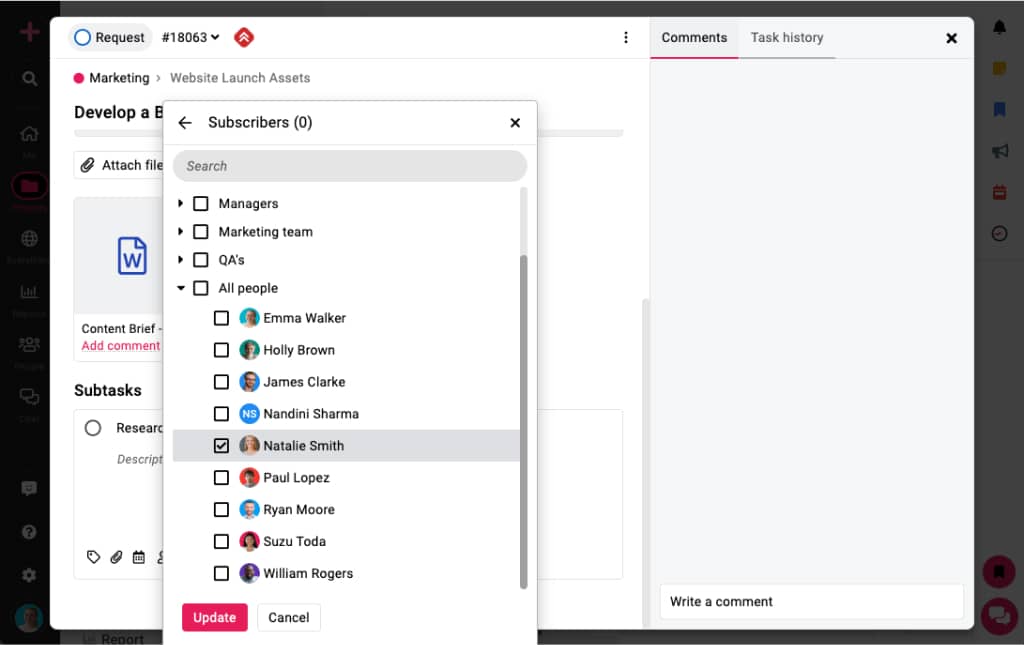
4. Set deadlines: Define a deadline for the subtask to ensure timely completion.
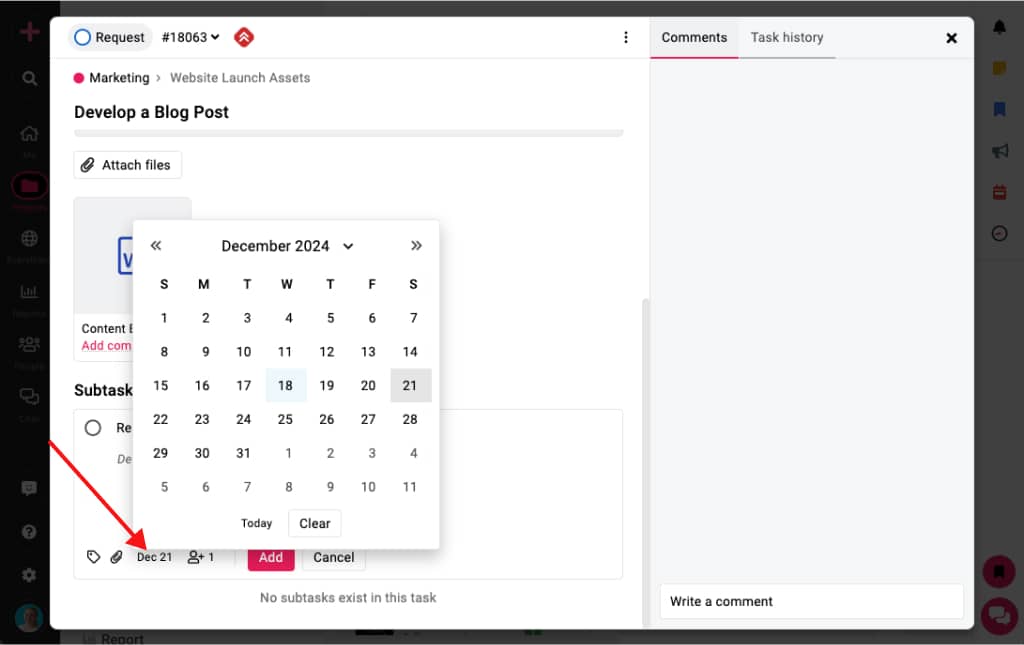
5. Track subtask details: Open the task detail window to view and edit subtasks as needed. You can monitor their progress, make updates, or reassign responsibilities.
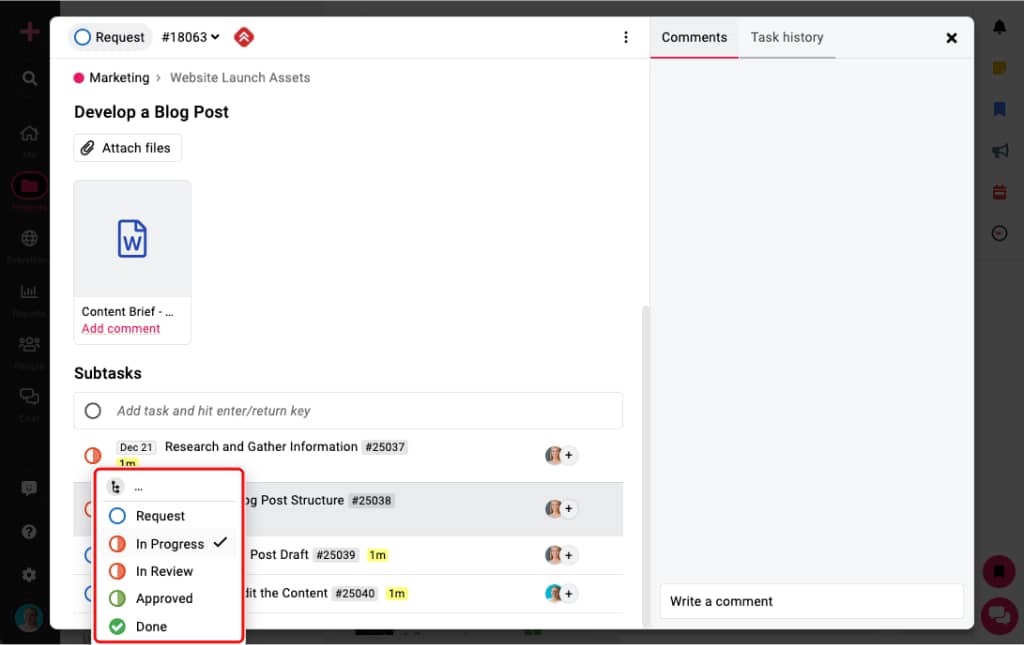
6. Convert subtasks if needed: Right-click on a subtask to convert it into a main task. This is particularly useful for dynamic projects where priorities shift frequently.
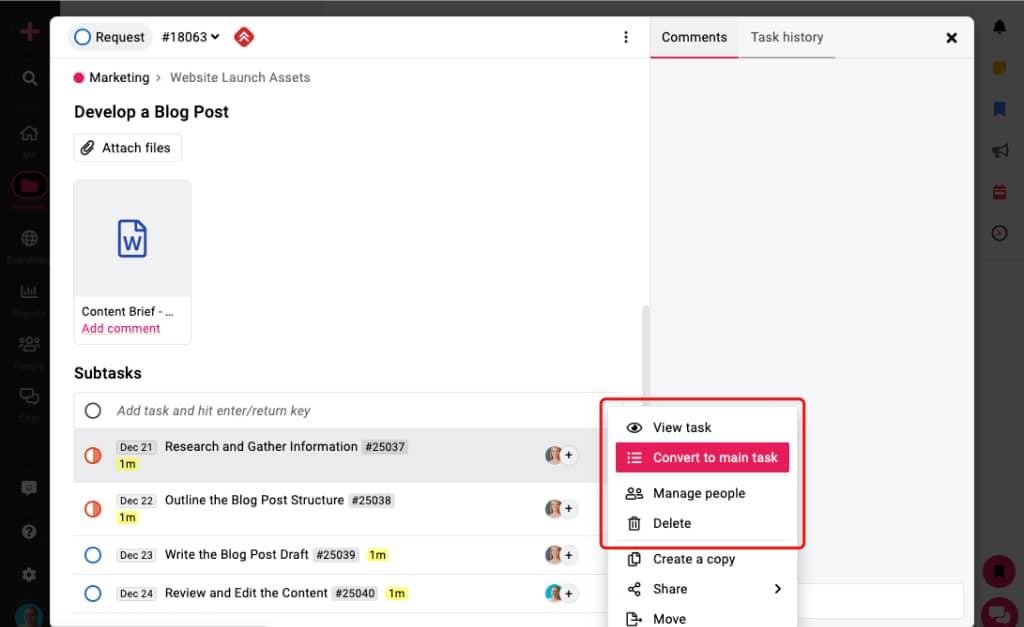
Subtasks are significant because they allow project managers to accurately assign resources to each task. They’re also helpful in predicting the progress of tasks because they show where potential disputes can arise inside the project.
Each task has several components that must be attended to. Previously, you could add a task, set a deadline, assign individuals, and describe to help clarify things. However, you can now divide each assignment into subtasks thereby making tasks manageable and way less complicated as well as bulky.
Each subtask functions as its task, with deadlines and individuals assigned. You don’t have to allocate people to the main task; you can do so immediately on the subtask or assign a group of people to the main task before assigning them to individual subtasks.
ProofHub makes project management and tracking easier by splitting down tasks into subtasks. Teams can collaborate more effectively, prevent overlaps, and meet deadlines with certainty.
The ability to allocate individuals to specific subtasks rather than the complete task reduces uncertainty and improves accountability.
ProofHub saves what matters the most, your TIME.
Common mistakes to avoid when using subtasks
Subtasks are incredibly useful for breaking down larger tasks into manageable parts. However, if misused, they can also create inefficiencies and confusion.
Here are some common mistakes you can make and how to avoid them:
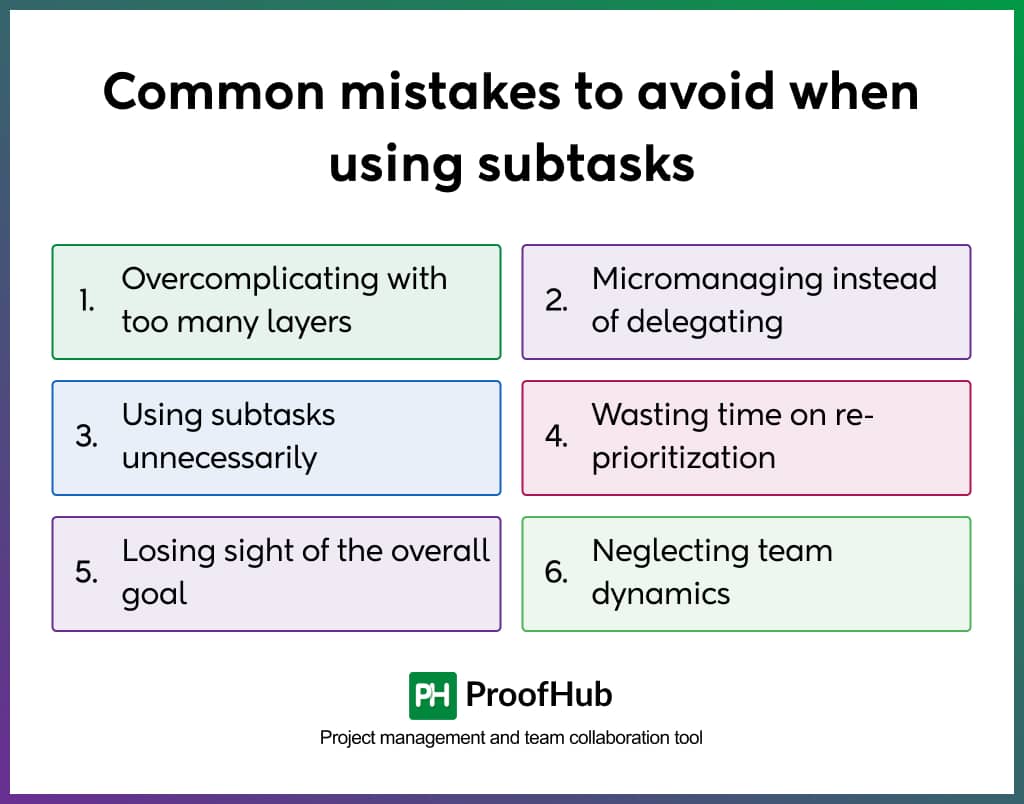
1. Overcomplicating with too many layers
Subtasks with multiple layers can quickly get out of hand, creating confusion and making it difficult to trace back to the parent task. This leads to delays and frustration within the team, as members struggle to understand how their work fits into the overall project.
And let’s be honest, you don’t want this chaos in your team! So, keep the hierarchy as simple as possible.
Use a maximum of one or two layers of subtasks and make sure that each directly contributes to the main task. You can also regularly review the task structure to avoid unnecessary complexity.
2. Micromanaging instead of delegating
Micromanaging every tiny detail can waste time (yours and your team’s as well) and erode trust within your team, leading to decreased morale and productivity. It often distracts project managers from focusing on strategic priorities, ultimately impacting the overall project delivery.
Trust your team to manage their responsibilities. Set clear expectations upfront (you can also toss in a motivational quote or two to boost the morale of your team members).
Also, check in occasionally to monitor progress without hovering over every detail. Empower your team to make decisions and take ownership of their tasks.
3. Using subtasks unnecessarily
Breaking tasks into subtasks when it’s not required can add unnecessary workload and demotivate your team. It can also clutter your task boards, making it harder to prioritize important work.
So, before you go all “task ninja” and slice that straightforward job into a million pieces, ask yourself: “Does this really deserve the subtask division?”
If a task is straightforward and can be completed independently, leave it as an individual task. It can boost your team members’ sense of accomplishment.
4. Wasting time on re-prioritization
Constantly adjusting subtasks due to poor initial planning leads to wasted time and disrupts the team’s workflow. This can result in missed deadlines and frustration.
By setting a clear structure from the start, you can save your team from unnecessary headaches. So, take a deep breath and spend some time upfront defining those tasks and subtasks.
You can use project management tools like ProofHub to establish priorities and dependencies, ensuring that the breakdown is logical and flexible enough to adapt to changes.
5. Losing sight of the overall goal
When team members are assigned subtasks without a clue how their work contributes to the overall goal, it leads to disengagement and reduced motivation. This disconnect can compromise the quality of work and hinder project success.
Always communicate the overarching vision of the project. Make sure everyone knows how each subtask ties into the main objectives and why it matters.
You can hold team meetings or share project briefs to lay it all out. Also, encourage open discussions to address any confusion and align the team on priorities, ensuring everyone is on the same page.
6. Neglecting team dynamics
If you are trying to manage tasks without considering the quirky dynamics of your team, it can be a big mistake! This leads to misunderstandings and reduced collaboration.
And before you know it, there are unexpected bottlenecks and a negative impact on your team’s overall efficiency. So, tilt that balance toward teamwork. Foster open communication and make sure everyone knows their role in the project.
You can set weekly goals and keep everyone aligned with regular updates. Also, recognize individual contributions to boost morale and team collaboration.
Boost your team collaboration and morale with these amazing team communication tools!
Best practices for managing subtasks
To keep your projects on pace and ensure that every detail is addressed, you need to effectively handle subtasks.
Here are some best practices to assist you manage your project’s subtasks:
- Break down tasks clearly: When creating subtasks, specify what needs to be done. The more explicit the description, the easier it will be for the team to comprehend what is required.
- Assign subtasks wisely: Do not overload a single team member with too many subtasks. Distribute them based on individual strengths and workload. A balanced approach ensures that nobody feels overwhelmed.
- Set reasonable deadlines: Keep track of the timeline for each subtask. Set attainable deadlines that are consistent with the overall project timeline, and don’t forget to leave some buffer time for unexpected obstacles.
- Prioritize subtasks: Not all subtasks are equivalent. Determine which jobs are most vital and should be completed first. This will allow your team to remain focused on what is most important.
- Use the appropriate tools: Use tools like ProofHub to track your subtasks. These tools offers robust task management features such as Gantt chart, Kanban boards, calendars, and many more that allow team members to check in on progress, leave comments, and easily communicate about any issues that arise.
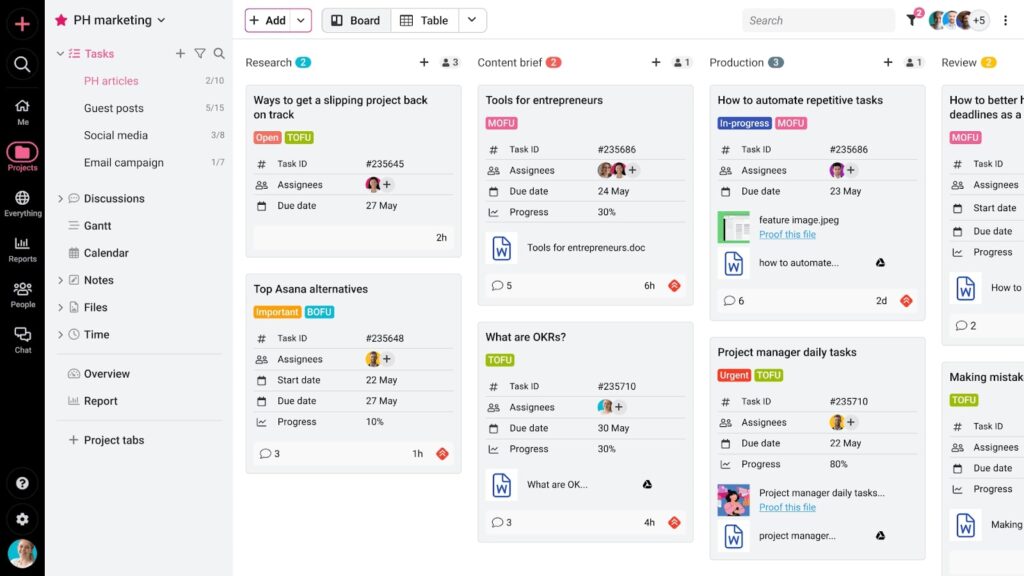
- Monitor progress regularly: Check in on subtask progress on a frequent basis, either in team meetings or using project management tools. This ensures that no work falls behind and that adjustments can be made swiftly.
- Keep communication open: Encourage your team to reach out if they encounter difficulties. Open communication ensures that issues are handled before they escalate into bigger problems.
- Review the accomplished subtasks: When a subtask is finished, take a moment to review it and collect feedback from team members – “What was their experience?” or “what can be changed?” Before proceeding, celebrate small wins and confirm that the work fulfills project criteria.
- Adjust subtasks if needed: As the project progresses, the needs of the team and the project itself may shift. Be adaptable and change subtasks as needed to ensure that everything runs well.
Wrapping Up
Subtasks can help you effectively distribute work and break down jobs into distinct components while remaining connected to the parent task’s overarching context. They are meant to augment and support the parent task’s primary job.
Subtasks are a terrific way to split down work into smaller chunks, clarify who’s working on what, and get things done. We can all agree that subtasks make project management easy and ensure all deadlines are met and tasks covered.
With a powerful yet easy-to-use task management tool like ProofHub, you can have a complete control over how your tasks and sub-tasks are planned, assigned, scheduled, and executed across projects.
But that’s not all! ProofHub also provides a comprehensive suite of project management and team collaboration features, which means you can manage teams, tasks, and projects from a single tool.
FAQs
How do subtasks improve team collaboration?
Subtasks are smaller and manageable chunks of tasks that make teamwork more organized. Each team member knows their role, thereby reducing confusion.
When there are shared responsibilities distributed among team members, they communicate better, stay aligned, and ensure that all contribute effectively to the bigger goal.
How can I ensure that all project subtasks align with the project’s overall goals?
To ensure that your project subtasks align with the project’s overall goals, you need to define clear project goals first. Then, map each subtask to these objectives and regularly review progress.
You can use project management tools like ProofHub to track your tasks and their progress, ensuring every subtask contributes to the main project’s success and nothing gets off track.
How can I effectively delegate subtasks to team members?
You can effectively delegate subtasks to your team members by understanding their strengths, weaknesses, and workload. Based on their skills and capacity, you can then assign them subtasks with clear instructions.
Regular check-ins allow you to monitor the progress, address challenges, and enable your team members to take ownership of their tasks.
How do I prioritize subtasks effectively?
You can rank your subtasks according to the deadlines, dependencies, and importance to prioritize them. Start with high-impact tasks and see what needs to be done first before the rest begins.
You can also use a Kanban board or priority matrix to effectively visualize and organize subtasks for clarity.
What’s the best way to handle overlapping subtasks?
Overlapping subtasks can cause confusion among your team members. To handle them properly, you need to identify overlaps first. Then, clarify roles, responsibilities, and dependencies.
Also, adjust timelines or workflows to minimize conflicts. Open communication can also help your team members coordinate efforts and stay aligned, avoiding unnecessary rework or delays.
